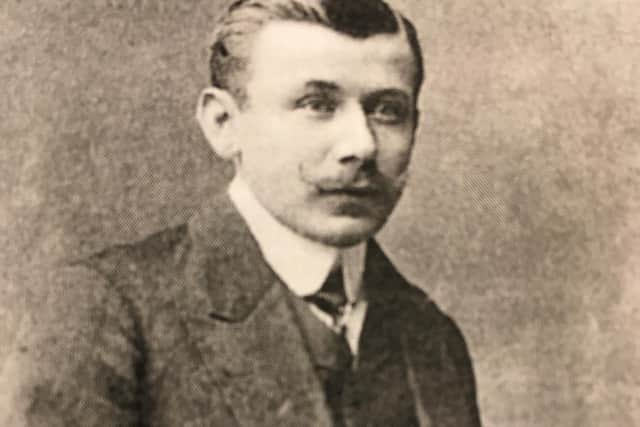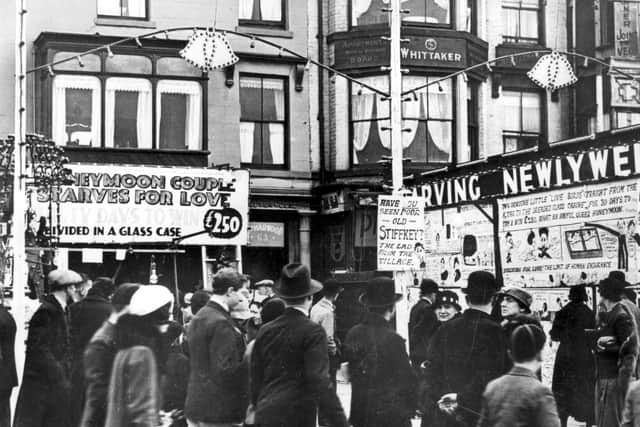Ricardo Sacco spent his final days in Blackpool encased in glass - starving himself for money
and live on Freeview channel 276
In the summer of 1929, a small amusement arcade on Church Street was pulling in huge crowds.
There was a menagerie on the ground floor of the arcade, but those things were old-fashioned by now, and this one wasn’t the reason hundreds of people were coming through the doors every day.
Advertisement
Hide AdAdvertisement
Hide AdThe big attraction was tucked away at the back of the premises.


There, behind tall screens, visitors would find a glass case containing a man who already looked pale and painfully thin.
This was Ricardo Sacco.
He had been a farmer and a baker, but now he called himself a ‘fasting man’. He was one of a select band of competitors who tried to last as long as they could without food.
These men came from the fairgrounds and ‘freak’ shows.


They were first popular in the years before the Great War. An American set the limit at 40 days, only for an Italian to take it to 45. A Swiss then fasted for 48 days, before an Austrian managed 52, 53 and then 60 days.
Advertisement
Hide AdAdvertisement
Hide AdSome of these men were frauds, and most were in it for the money.
Ricardo claimed to have broken the record several times, but it was in the 1920s that he experienced both his greatest success and his final, tragic failure.
Fasting men were popular again now, when they seemed to have as much in common with the marathon dancers and flagpole-sitters who were suddenly everywhere.
His real name was Richard Hans Jöne, and he was born in Utrecht, in the Netherlands. He said he had run away from the farm to join a circus, and during the war he had served with the British Army.
In London one Christmas, he managed 45 days without food.
Advertisement
Hide AdAdvertisement
Hide AdThen, the following summer, he set himself up at the Kursaal in Southend, vowing to beat the record.
He collapsed after 47 days, however, and was told by doctors that he would die if he went on. When he stepped out of his case, he was given warm milk and brandy.
Meanwhile, a Kiwi who called himself Raymond Tac took the record beyond 60 days.
Ricardo Sacco’s response was to move his case to Manchester.
Advertisement
Hide AdAdvertisement
Hide AdOver Christmas 1928, he was part of an exhibition on Oldham Street that also included ‘The Mystery Bat,’ ‘The Tattooed Venus’ and ‘The Lobster-clawed Girl’.
The case was again a glass one, with a small grill let into one side, so that Ricardo could speak to visitors. There was also a slot through which his temperature could be taken and his blood pressure checked.
Inside the case he had a bed and an armchair. There were piles of books and magazines, and stocks of the soda water and cigarettes that would be his only sustenance.
But those things didn’t sustain him for very long.
After barely a month, he had become very pale, his cheekbones were sticking out, and there were dark rings around his eyes. ‘I am not suffering any pain,’ he told a reporter, ‘but I am feeling very weak.’
Advertisement
Hide AdAdvertisement
Hide AdHe managed only another few days before giving up, and by the time he staggered out of the case, he was unable to speak a single word.
When Ricardo Sacco came to Blackpool, he said that his next fast would be his last one.
That prediction proved correct, though not for the reason he had envisaged.
Having taken lodgings on Cookson Street, he pitched his glass case at 76, Church Street, just down from the Winter Gardens, and opposite the junction with Coronation Street.
This would be a competitive summer.
Advertisement
Hide AdAdvertisement
Hide AdThe day before Ricardo began his fast, a man named Billie Brown had done the same in Barry Island, and when Billie heard what was going on in Blackpool, he pledged to continue ‘until Sacco throws in the sponge.’
Ricardo even had a competitor in Blackpool itself, where a man named Clark soon claimed to have set a new record from a glass case set up not in Church Street, but on the Golden Mile.
From the start there was doubt about Ricardo’s health.
A fine figure of a man in his earlier days, he was now nearly fifty and said to have been reduced to little more than a skeleton by all his fasting. He had indigestion and a liver complaint.
He would, once again, be sustained by soda water and cigarettes, and for a while, everything seemed to be going well.
Advertisement
Hide AdAdvertisement
Hide AdRicardo would spend the days with his books and newspapers, or chatting to the people who flocked around him.
He would also respond to the fan-letters he received, of which there were many. They often came from women, who sometimes enclosed photographs of themselves and even asked to be allowed to share his glass case.
He surpassed his own record before August was out, and Raymond Tac’s record only a few days later. But then, his health began to deteriorate.
Ricardo was visited in Church Street by a nurse, Ethel Barlow, who didn’t like what she saw.
Advertisement
Hide AdAdvertisement
Hide AdThe glass case was filthy, she later said, and the arcade smelled very bad. There were monkeys and birds everywhere, and even what she described as ‘funny cats’. Ricardo had said that it disgusted him as well.
He was on the point of giving up, Ethel said, but he dearly wanted to beat Mr Clark.
On Sunday, September 15, Ricardo saw a local doctor named Ward. He had lost more than a quarter of his body weight and was now emaciated and very, very weak.
On the advice of Dr Ward, Ricardo abandoned his fast, having managed to keep it going for 65 days.
Advertisement
Hide AdAdvertisement
Hide AdHe was immediately given milk and water and taken back to Cookson Street, where he would be fed on chicken, fish and eggs, and confined to bed.
But while this was the longest fast Ricardo had managed, it wasn’t long enough to make him a champion.
On hearing that his rival had indeed thrown in the sponge, Billie Brown did the same, having managed to last fully 67 days without food. He too was given milk and eggs, before being kissed by his wife and congratulated by the mayor, and falling sound asleep.
At home on Cookson Street, Ricardo continued to receive visitors, telling them that he would try his luck in America once he had recovered.
Advertisement
Hide AdAdvertisement
Hide AdGradually, though, his health and mood deteriorated still further, and thoughts of America slipped away. ‘They have killed me this time,’ he told Nurse Barlow, but he didn’t mention any names.
On November 3, seven weeks after he had abandoned his fast, Ricardo Sacco died, leaving a widow and a teenage daughter, and an estate worth less than £3,000 today.
At the inquest, a few days later, Dr Ward said that Ricardo had died from a heart attack following organ failure and liver cirrhosis. And he accepted that the true cause might have been his last fast and the ones that preceded it.
He had examined Ricardo back in June, he said, and advised him not to proceed.
Advertisement
Hide AdAdvertisement
Hide AdThe coroner, Harold Parker, did not hold back. ‘It is clear that this man was out to make money in what most people would regard as the most revolting way,’ he said.
Recording a verdict of ‘death by misadventure’, Colonel Parke also had a word for the thousands who had surrounded the dingy glass case in the squalid arcade. ‘How people can be induced to go and see a man who is treating himself in this way I cannot conceive,’ he said.
Ricardo’s funeral was held at Sacred Heart church on Talbot Road. The place was packed with mourners, many of them women, some of them in tears. He was laid to rest in Layton Cemetery.
The only one of Ricardo Sacco’s competitors to attend the funeral was Raymond Tac. He would soon claim to have gone 68 days without eating – only for a man from Stockport to claim that he had managed two days more.